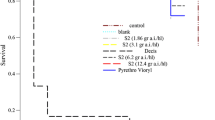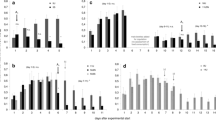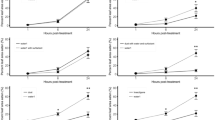Abstract
In the years between 1890 and 1950 the use of tarred felt discs and naphthalene flakes enabled cabbage growers to controlD. brassicae in a for that time satisfactory way. Resistance- and residue problems with insecticides and the recent development of controlled release compounds resulted in a new approach of the use of insecticides and particularly of volatiles influencing behaviour. In field experiments dispersions of polymers loaded with the repellents tar and naphthalene were sprayed around the stem base of cauliflower plants and the effect of clay slurry discs mixed with these repellents was also studied. The degree of control was assessed by weekly stand scoring and by estimation of the root damage index.
In a second series of field trials the results of the polymer dispersion discs mentioned were compared to those obtained by applying three component granules (a polymer, a copolymer and 30% naphthalene) or sprayed discs of a similar composition. Untreated and trichloronatetreated plants were used as a standard.
Some of the naphthalene compounds almost equalled the effect of trichloronate on the development and size of the plants. The root damage indices, however, showed less favourable figures although their level was far below that of the untreated plants.
Adaptation of the controlled release polymer compositions to particular field situations (pH, soil type) in the future may lead to a further improvement of the results.
Samenvatting
Voor de bestrijding van de koolvlieg (Delia brassicae) werden in de periode van 1890 tot 1950 koolkragen gebruikt. Het in teer gedrenkte karton of vilt fungeerde als mechanische barrière en als afstotend middel tegen de eileggende koolvlieg en zijn larve. Als zodanig werden sinds 1918 ook naftalineschilfers toegepast.
Resistentie- en residuproblemen bij het gebruik van insekticiden en de ont wikkeling van kunststofverbindingen geschikt voor langzame afgifte van daarmee gemengde vluchtige verbindingen leidden tot hernieuwd onderzoek naar de werking van naftaline als repellens.
In veldproeven werd de werking van polymeren beladen met de repellentia teer en naftaline tegen koolvlieg onderzocht aan de hand van gewasontwikkeling en wortelschade-indices. Enkele van de systemen met vertraagde afgifte evenaarden bijna het effect van het insekticide trichloronate op ontwikkeling en grootte der planten bovengronds. De wortelschade aan het einde van de proeven was echter niet minimaal, zoals na insekticidebehandeling, doch aanzienlijk minder dan bij onbehandelde planten. Combinatie van deze twee gegevens wijst op het ontstaan van een aanzienlijke tolerantie van de bloemkoolplanten in de eerste periode van de groei.
Aanpassing van genoemde kunststofverbindingen aan speciale veldsituaties als pH en bodemtype kan in de toekomst leiden tot verbetering der resultaten.
Similar content being viewed by others
References
Allan, G. G., Friedhoff, J. F., McConnel, W. J. & Powell, J. C., 1976. The controlled release of bioactive compounds from polymeric systems. J. Macromol. Sci. — Chem. A10 (1 & 2). pp. 223–244.
Anonymus (OILB), 1976. Unpublished.
Cardarelli, N., 1975. Controlled release pesticide formulations. C.R.C. Press, Cleveland, Ohio.
Brown, A. W. A., 1971. Pest resistance to pesticides. In: R. White-Stevens (Ed.), Pesticides in the environment. Vol. I, part II, pp. 457–552. Marcel Dekker, New York.
Coaker, T., 1969. New approach to cabbage root fly control. Proc. 5th Br. Insect. Fungic. Conf. 3: 704–710.
Coaker, T. H. & Finch, S., 1965. The control of cabbage root fly on edible brassicae. Pl. Path. 14: 1.
Glass, E. H., 1975. Integrated pest management: rational, potential, needs and implementation. Entomological Society of America. Special Publication 75(2).
Harris, C. R. & Svec, H. J., 1976. Onion maggot resistance to insecticides. J. Econ. Ent. 69: 617–620.
Heslinga, A. & Willigen, C. A. van der, 1979. Water degradable polymer blends by polyelectrolyte formation in poly(vinyl acetate). Journal of Applied Polymers Science: Applied Polymer Symposium 35. 000-000 (1979) 0570-4898/79/0035-XXXX 501.00.
Sant, L. E. van’t, 1961. Levenswijze en bestrijding van de wortelvlieg (Psila rosae F.) in Nederland. Versl. landbouwk. onderz- Nr. 67.1 Wageningen.
Slingerland, M. V., 1894. The cabbage root maggot. Bull. Cornell Univ. agric. Exp. Stn. 78.
Author information
Authors and Affiliations
Rights and permissions
About this article
Cite this article
Den Ouden, H., Theunissen, J. Controlled release of naphthalene: a repellent against oviposition of the cabbage root fly, Delia brassicae. Netherlands Journal of Plant Pathology 86, 17–25 (1980). https://doi.org/10.1007/BF02650389
Accepted:
Issue Date:
DOI: https://doi.org/10.1007/BF02650389




